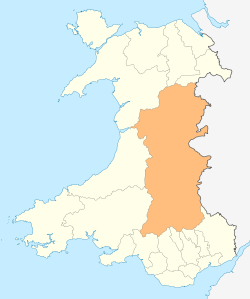Welshpool railway station
| Welshpool | |
|---|---|
| Welsh: Y Trallwng | |
 | |
| Location | |
| Place | Welshpool |
| Local authority | Powys |
| Grid reference | SJ229072 |
| Operations | |
| Station code | WLP |
| Managed by | Arriva Trains Wales |
| Number of platforms | 2 |
| DfT category | F1 |
|
Live arrivals/departures, station information and onward connections from National Rail Enquiries | |
| Annual rail passenger usage* | |
| 2004/05 | 70,833 |
| 2005/06 |
|
| 2006/07 |
|
| 2007/08 |
|
| 2008/09 |
|
| 2009/10 |
|
| 2010/11 |
|
| 2011/12 |
|
| 2012/13 |
|
| 2013/14 |
|
| 2014/15 |
|
| History | |
| 14 August 1860 | opened |
| 18 May 1992[1] | Original station closed and new station opened on track realignment. |
| National Rail – UK railway stations | |
| * Annual estimated passenger usage based on sales of tickets in stated financial year(s) which end or originate at Welshpool from Office of Rail and Road statistics. Methodology may vary year on year. | |
|
| |
Welshpool railway station on the Cambrian Line in Powys, mid-Wales, serves the town of Welshpool (Welsh: Y Trallwng).
History

Built by the Oswestry and Newtown Railway, the original station opened on 14 August 1860.[2] The line was initially operated by the London and North Western Railway before being absorbed by the Cambrian Railways, which became part of the Great Western Railway at the grouping which came into effect on 1 January 1923.
Midland Counties Dairy bought and operated the creamery at Cilcewydd. A siding from the station gave access for milk trains to the creamery.
About 100 metres north of the station were exchange sidings with the narrow gauge Welshpool and Llanfair Light Railway which opened for freight traffic in 1903 and closed in 1956 with a separate station serving passenger traffic until 1931. The last remains of this station and the site of the railway were obliterated by the construction of the new A483 road .
Present

There was some severe rationalisation of services under the Beeching Axe in the 1960s. Subsequent development of the A483 road Welshpool bypass (opened in July 1993)[3] required the railway line to be shifted to the south. To enable this the original station was closed, and a new single island platform constructed by British Rail south of it, to allow realignment in 1992.
The replacement station platform is reached by a pedestrian bridge crossing both the railway and the A483, with long uncovered inclines to the north and stepped access from the south. There are no facilities beyond a small shelter, benches, passenger information displays and a help point. The original station building can still be seen across the road, and has been converted into a mill shop and café.
The passing loop was later extended to 2.5 miles (4.0 km) to allow for an hourly train service, and to reduce the impact of delays on the line.
The station was used by HM Queen Elizabeth II when she came on an official visit to the town on 28 April 2010. She arrived and departed on the Royal Train.
Services
Trains run from here westwards to Machynlleth and then either Aberystwyth or Pwllheli via Barmouth (most trains convey a portion for both routes) and eastwards to Shrewsbury & Birmingham International. There is a basic two-hourly service each way - on weekdays & Saturdays with additional hourly Shrewsbury to Aberystwyth services till mid morning & again during late afternoon and early evenings. On Sundays there is a two-hourly service on the Shrewsbury - Aberystwyth axis, but only a limited service along the coast to/from Pwllheli (three in summer and one in winter).[4]
References
- ↑ http://www.disused-stations.org.uk/w/welshpool_1st/index.shtml
- ↑ http://www.disused-stations.org.uk/w/welshpool_1st/index.shtml
- ↑ Hansard
- ↑ GB eNRT 2015-16 Edition, Table 76 (Network Rail)
External links
- Train times and station information for Welshpool railway station from National Rail
| Preceding station | Following station | |||
|---|---|---|---|---|
| Arriva Trains Wales |
Coordinates: 52°39′27″N 3°08′24″W / 52.657469°N 3.139947°W
